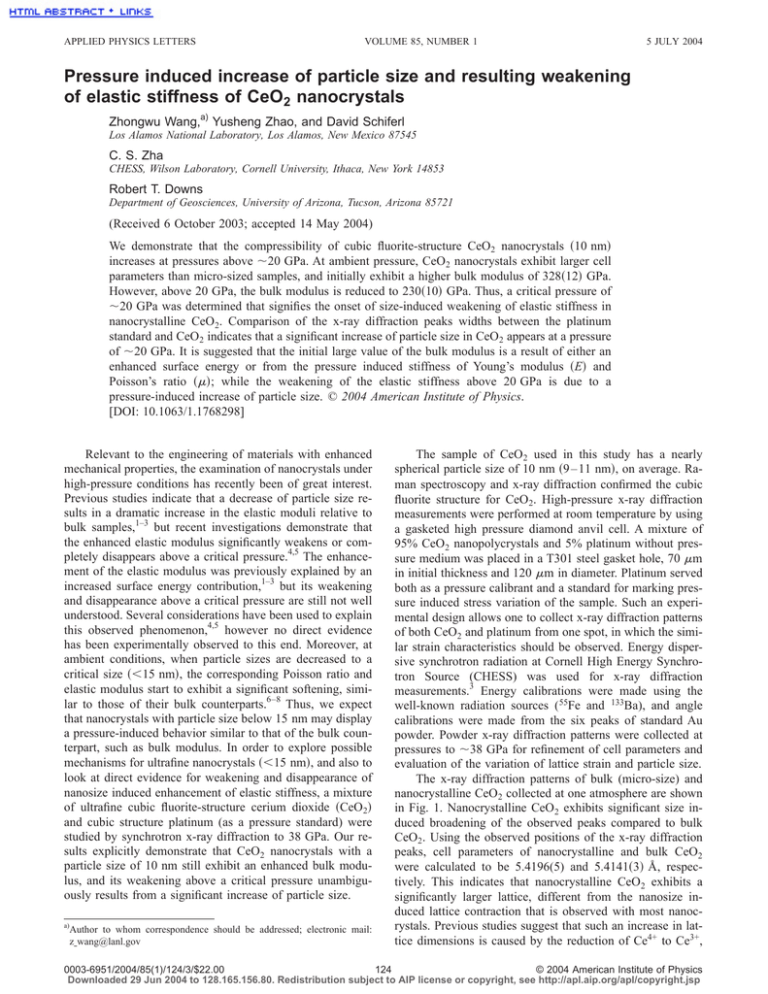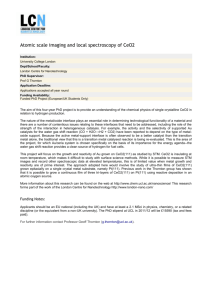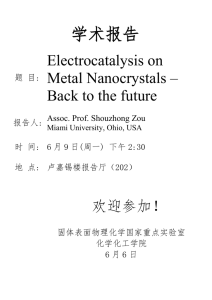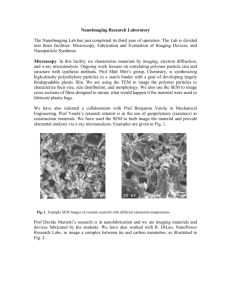Pressure induced increase of particle size and resulting weakening nanocrystals
advertisement

APPLIED PHYSICS LETTERS VOLUME 85, NUMBER 1 5 JULY 2004 Pressure induced increase of particle size and resulting weakening of elastic stiffness of CeO2 nanocrystals Zhongwu Wang,a) Yusheng Zhao, and David Schiferl Los Alamos National Laboratory, Los Alamos, New Mexico 87545 C. S. Zha CHESS, Wilson Laboratory, Cornell University, Ithaca, New York 14853 Robert T. Downs Department of Geosciences, University of Arizona, Tucson, Arizona 85721 (Received 6 October 2003; accepted 14 May 2004) We demonstrate that the compressibility of cubic fluorite-structure CeO2 nanocrystals 共10 nm兲 increases at pressures above ⬃20 GPa. At ambient pressure, CeO2 nanocrystals exhibit larger cell parameters than micro-sized samples, and initially exhibit a higher bulk modulus of 328共12兲 GPa. However, above 20 GPa, the bulk modulus is reduced to 230共10兲 GPa. Thus, a critical pressure of ⬃20 GPa was determined that signifies the onset of size-induced weakening of elastic stiffness in nanocrystalline CeO2. Comparison of the x-ray diffraction peaks widths between the platinum standard and CeO2 indicates that a significant increase of particle size in CeO2 appears at a pressure of ⬃20 GPa. It is suggested that the initial large value of the bulk modulus is a result of either an enhanced surface energy or from the pressure induced stiffness of Young’s modulus 共E兲 and Poisson’s ratio 共兲; while the weakening of the elastic stiffness above 20 GPa is due to a pressure-induced increase of particle size. © 2004 American Institute of Physics. [DOI: 10.1063/1.1768298] Relevant to the engineering of materials with enhanced mechanical properties, the examination of nanocrystals under high-pressure conditions has recently been of great interest. Previous studies indicate that a decrease of particle size results in a dramatic increase in the elastic moduli relative to bulk samples,1–3 but recent investigations demonstrate that the enhanced elastic modulus significantly weakens or completely disappears above a critical pressure.4,5 The enhancement of the elastic modulus was previously explained by an increased surface energy contribution,1–3 but its weakening and disappearance above a critical pressure are still not well understood. Several considerations have been used to explain this observed phenomenon,4,5 however no direct evidence has been experimentally observed to this end. Moreover, at ambient conditions, when particle sizes are decreased to a critical size 共⬍15 nm兲, the corresponding Poisson ratio and elastic modulus start to exhibit a significant softening, similar to those of their bulk counterparts.6–8 Thus, we expect that nanocrystals with particle size below 15 nm may display a pressure-induced behavior similar to that of the bulk counterpart, such as bulk modulus. In order to explore possible mechanisms for ultrafine nanocrystals 共⬍15 nm兲, and also to look at direct evidence for weakening and disappearance of nanosize induced enhancement of elastic stiffness, a mixture of ultrafine cubic fluorite-structure cerium dioxide 共CeO2兲 and cubic structure platinum (as a pressure standard) were studied by synchrotron x-ray diffraction to 38 GPa. Our results explicitly demonstrate that CeO2 nanocrystals with a particle size of 10 nm still exhibit an enhanced bulk modulus, and its weakening above a critical pressure unambiguously results from a significant increase of particle size. a) Author to whom correspondence should be addressed; electronic mail: zគwang@lanl.gov The sample of CeO2 used in this study has a nearly spherical particle size of 10 nm 共9 – 11 nm兲, on average. Raman spectroscopy and x-ray diffraction confirmed the cubic fluorite structure for CeO2. High-pressure x-ray diffraction measurements were performed at room temperature by using a gasketed high pressure diamond anvil cell. A mixture of 95% CeO2 nanopolycrystals and 5% platinum without pressure medium was placed in a T301 steel gasket hole, 70 m in initial thickness and 120 m in diameter. Platinum served both as a pressure calibrant and a standard for marking pressure induced stress variation of the sample. Such an experimental design allows one to collect x-ray diffraction patterns of both CeO2 and platinum from one spot, in which the similar strain characteristics should be observed. Energy dispersive synchrotron radiation at Cornell High Energy Synchrotron Source (CHESS) was used for x-ray diffraction measurements.3 Energy calibrations were made using the well-known radiation sources (55Fe and 133Ba), and angle calibrations were made from the six peaks of standard Au powder. Powder x-ray diffraction patterns were collected at pressures to ⬃38 GPa for refinement of cell parameters and evaluation of the variation of lattice strain and particle size. The x-ray diffraction patterns of bulk (micro-size) and nanocrystalline CeO2 collected at one atmosphere are shown in Fig. 1. Nanocrystalline CeO2 exhibits significant size induced broadening of the observed peaks compared to bulk CeO2. Using the observed positions of the x-ray diffraction peaks, cell parameters of nanocrystalline and bulk CeO2 were calculated to be 5.4196(5) and 5.4141共3兲 Å, respectively. This indicates that nanocrystalline CeO2 exhibits a significantly larger lattice, different from the nanosize induced lattice contraction that is observed with most nanocrystals. Previous studies suggest that such an increase in lattice dimensions is caused by the reduction of Ce4+ to Ce3+, 0003-6951/2004/85(1)/124/3/$22.00 124 © 2004 American Institute of Physics Downloaded 29 Jun 2004 to 128.165.156.80. Redistribution subject to AIP license or copyright, see http://apl.aip.org/apl/copyright.jsp Appl. Phys. Lett., Vol. 85, No. 1, 5 July 2004 Wang et al. 125 FIG. 1. Comparison of x-ray diffraction patterns of bulk and nanocrystalline CeO2. FIG. 3. Linewidth broadening of the x-ray diffraction plane (111) and its FWHM for the platinum standard under pressure. when the particle size is reduced to 20 nm.9–11 Correlations that were previously obtained between lattice size increase and reduced ration of Ce3+ / Ce4+ suggest that about 0.8% molar Ce4+ in the CeO2 sample was reduced to Ce3+.9 Surface energy contributions usually lead to a contraction of the particle shell layer, in which the large d spacings display the greatest deviations. Thus, two controversial effects compensate and result in the same d-spacing value for the diffraction planes (111) and (200) with the largest d spacings for nanosize and bulk CeO2 (Fig. 1). But, the small d spacings of nanocrystalline CeO2 apparently shift to higher values relative to those of bulk CeO2. Since the determination of the cell parameter is mostly influenced by the values of the small d spacings, it is reasonable to observe a lattice expansion in the nanocrystalline CeO2. Average cell parameters were calculated from the observed diffraction patterns of nanocrystalline CeO2 at each pressure. A third-order Birch–Murnaghan equation of state (EOS) was fit to the observed pressure–volume data. As shown in Fig. 2, a noticeable discontinuity appears at ⬃20 GPa. Therefore, we fit the P – V data with two distinct EOS curves that appear to be reasonably constrained (Fig. 2). It is notable that the curve fit to the data above 20 GPa matches previous data collected from bulk CeO2.12 Upon compression, the bulk modulus below 20 GPa is 328共12兲 GPa with K⬘ ⬅ 4, which is greater than that of micro-size polycrystalline CeO2 关230 共10兲 GPa兴.12 Such an high bulk modulus is likely due to the nanocrystalline effect, as also observed for nanocrystalline Si3N4 and Ge3N4 with extremely high bulk moduli of 685(45) and 381共2兲 GPa, respectively.4,5 These results signify that the nanosize induced enhancement of elastic stiffness in CeO2 nanocrystals apparently weakens at a critical pressure of ⬃20 GPa. In order to clarify the resulting mechanism for the observed high-pressure properties, we compared the pressureinduced variation of peak broadening of platinum and CeO2 in order to analyze the pressure profiles of the lattice strain and particle size. Since both platinum and CeO2 have cubic structures that are elastically isotropic, each of the lattice planes is subject to the same strain. Therefore, we only use the (111) peak, which is strong and does not overlap with other peaks, to evaluate the pressure-induced variation of particle size and lattice strain. Line broadening of the x-ray diffraction peaks is related to the reduction of particle size and enhancement of lattice strain. The peak width variation of the (111) plane of platinum and its Full width at half maximum (FWHM) profile as a function of pressure are shown in Fig. 3, which indicates that elevation of pressure gradually enhances lattice strain of the sample. Since the x-ray diffraction pattern of nanocrystalline CeO2 was collected at the same spot as that of platinum, the lattice strain profile of the CeO2 sample should exhibit similar characteristics, assuming that equal strain is generated in the two coexisting compounds at the same pressure conditions. However, as shown in Fig. 4, the peak variations of the (111) plane of CeO2 and its FWHM values display quite different pressure-dependent profiles. A Significant decrease of the FWHM value occurs at a pressure of ⬃20 GPa. As observed FIG. 4. Linewidth broadening of the x-ray diffraction plane (111) and its FWHM for the CeO2 nanocrystals. FIG. 2. Room temperature equation-of-state data for nanocrystalline CeO2. Downloaded 29 Jun 2004 to 128.165.156.80. Redistribution subject to AIP license or copyright, see http://apl.aip.org/apl/copyright.jsp 126 Wang et al. Appl. Phys. Lett., Vol. 85, No. 1, 5 July 2004 for platinum, no significant discontinuity of lattice strain variance appears as pressure increases from 1 atm to 38 GPa, so the observed kink of line broadening in CeO2 can only result from an enlargement of particle size of CeO2 nanocrystals. This further suggests that a significant increase in the particle size of CeO2 takes place at a pressure of ⬃20 GPa. These results imply that nanosize-induced effects in CeO2 result in a significant increase of bulk modulus below 20 GPa; upon additional compression 共⬎20 GPa兲, the nanosize-induced effect appears to be suppressed by pressure induced increase of particle size, resulting in a considerable weakening of the elastic stiffness of CeO2. Previous high-pressure studies identified two types of behavior in nanocrystalline materials: one is associated with a larger bulk modulus upon reduction in particle size;1–3 while the other associates the same compressibility as that in the bulk counterpart.13–15 For the first type, all previously studied materials were investigated only at lower pressures,1–3 and all the bulk materials exhibit phase transitions at relatively low pressures. In contrast, the second type of nanocrystals was studied under extreme compression,13–15 since their bulk counterparts are stable over a wide range of pressure. Recent studies of spinel structure Si3N4 and Ge3N4 nanocrystals indicate that the size-induced enhancement of the bulk modulus is weakened or disappears above a critical pressure,4,5 which explains the compressional properties exhibited by the two types of nanocrystals, but the resulting mechanism for such an observed phenomenon still remains ambiguous. Moreover, a large number of studies indicate that surface energy contribution leads to a contract effect of lattice and enhanced elastic properties, but below the critical size 共⬍15 nm兲, a lattice dimension increase and elastic softening effect were observed.6–8 Therefore, it is expected that different high pressure behavior may occur in these ultrafine nanocrystals compared with those observed previously from nanocrystals with particle size above 15 nm.1–3 This further implies that the nanocrystalline effect may not alter the bulk modulus. Several studies demonstrate that CeO2 nanocrystals with particle size of ⬍20 nm exhibit an increase in lattice dimension.9–11 This is confirmed by our results. However, our high-pressure studies do not support our expectation of the same bulk modulus in such an ultrafine nanocrystals. In contrast, an enhanced bulk modulus is still observed. As is well known, the bulk modulus 共K兲 involves both the Young’s modulus 共E兲 and Poisson’s ratio 共兲, and either enhancement of Young’s modulus or Poisson’s ratio can lead to an increase of the bulk modulus. Previous studies indicate that a reduction of particle size results in a significant enhancement of Young’s modulus and of Poisson’s ratio,7–9 but below a critical size, both of them exhibit a remarkable softening.8,9 Thus, two possibilities are considered to explain our results. One may suggest that the nanosize still plays a critical role, and results in an enhanced bulk modulus; another may be a pressure-induced stiffness of both Young’s modulus and Poisson’ ratio in such ultrafine nanocrystals. Moreover, compared with the lattice strain profiles obtained from platinum, an apparent kink in the linewidth broadening of the x-ray diffraction profiles (111) of CeO2 nanocrystals at a pressure of ⬃20 GPa provides unambiguous evidence that a significant increase of particle size occurs at this critical pressure. This is a key factor in the weakening and further disappearance of the pressure-induced incompressibility of the CeO2 nanocrystals. Such an observation and the corresponding in- terpretation can also be used to explain the observed phenomena of other nanocrystals. It is suggested that the sizeinduced effect plays a vital role in the particular properties of nanocrystals over a wide range of particle size only below a critical pressure, and correspondingly results in an enhancement of the bulk modulus; upon additional pressure, the particle size apparently increases, leading to the same weaker incompressibility as observed in the bulk counterpart. Furthermore, our result can also explain why the two types of behavior were observed for nanocrystals in previous studies.1–3,13–15 An important consideration is whether previous experiments reached the required critical pressures or not. It is pointed out that the resulting mechanism for the abrupt increase of particle size near 20 GPa still remains mysterious. This cannot be interpreted by the simple fusing of particles together that is commonly observed in pressure studies, since the resulting particle coarsening would increase gradually with pressure. Thus, one consideration may be due to the pressure-induced cold welding in which a critical condition is theoretically needed for overcoming the energy gap. In summary, we have carried out in situ synchrotron x-ray diffraction to explore the size-induced compressional effect in nanocrystalline CeO2 to pressures of 38 GPa. Results indicate that at a critical pressure of ⬃20 GPa, there is a significant weakening of the size-induced effect in nanocrystalline CeO2. Below and above this pressure, the bulk moduli were calculated to be 328(12) and 230共10兲 GPa, respectively. Thus, it is suggested that the initial enhancement of bulk modulus may result either from an enhanced surface energy contribution or from a pressure induced stiffness of Young’s modulus 共E兲 and Poisson’s ratio 共兲. The observed decrease in the bulk modulus at a critical pressure of ⬃20 GPa appears to be a consequence of particle size enlargement. This result provides a reasonable explanation for the existing irreconcilable compression behaviors of different nanocrystals. 1 S. H. Tolbert and A. P. Alivisatos, Annu. Rev. Phys. Chem. 46, 595 (1995). 2 J. Z. Jiang, J. S. Olsen, L. Gerward, and S. Morup, Europhys. Lett. 44, 620 (1998). 3 Z. W. Wang, S. K. Saxena, V. Pischedda, H. P. Liermann, and C. S. Zha, Phys. Rev. B 64, 012102 (2001). 4 Z. W. Wang, Y. Zhao, D. Schiferl, C. S. Zha, R. T. Downs, and T. Sekine, Appl. Phys. Lett. 83, 3174 (2003). 5 Z. W. Wang, Y. Zhao, D. Schiferl, J. Qiang, R. T. Downs, H. K. Mao, and T. Sekine, J. Phys. Chem. B 107, 14151 (2003). 6 P. Villain, P. Goudeau, P. O. Renault, and K. F. Badawi, Appl. Phys. Lett. 81, 4365 (2002). 7 T. D. Shen, C. C. Koch, T. Y. Tsui, and G. M. Pharr, J. Mater. Res. 10, 2892 (1995). 8 Y. Zhou, U. Erb, K. T. Aust, and G. Palumbo, Scr. Mater. 48, 825 (2003). 9 J. E. Spanier, R. D. Robinson, F. Zhang, S. W. Chan, and I. P. Herman, Phys. Rev. B 64, 245407 (2001). 10 S. Tsunekawa, K. Ishikawa, Z. Q. Li, Y. Kawazoe, and A. Kasuya, Phys. Rev. Lett. 85, 3440 (2000). 11 X. D. Zhou and W. Huebner, Appl. Phys. Lett. 79, 3512 (2001). 12 S. J. Duclos, Y. K. Vohra, A. L. Ruoff, A. Jayaraman, and J. P. Espinosa, Phys. Rev. B 38, 7755 (1988). 13 S. Rekhi, S. K. Saxena, Z. D. Atlas, and J. Hu, Solid State Commun. 117, 33 (2000). 14 Z. W. Wang, V. Pischedda, S. K. Saxena, and P. Lazor, Solid State Commun. 121, 275 (2002). 15 B. Chen, D. Penwell, and M. B. Kruger, Solid State Commun. 115, 191 (2000). Downloaded 29 Jun 2004 to 128.165.156.80. Redistribution subject to AIP license or copyright, see http://apl.aip.org/apl/copyright.jsp






